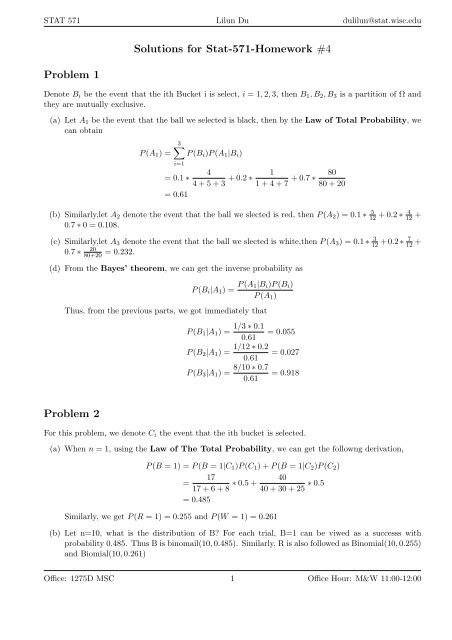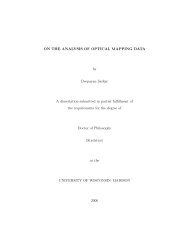Solutions for Stat-571-Homework #4 Problem 1 Problem 2
Solutions for Stat-571-Homework #4 Problem 1 Problem 2
Solutions for Stat-571-Homework #4 Problem 1 Problem 2
Create successful ePaper yourself
Turn your PDF publications into a flip-book with our unique Google optimized e-Paper software.
STAT <strong>571</strong> Lilun Du dulilun@stat.wisc.edu<br />
<strong>Problem</strong> 1<br />
<strong>Solutions</strong> <strong>for</strong> <strong>Stat</strong>-<strong>571</strong>-<strong>Homework</strong> <strong>#4</strong><br />
Denote B i be the event that the ith Bucket i is select, i = 1, 2, 3, then B 1 , B 2 , B 3 is a partition of Ω and<br />
they are mutually exclusive.<br />
(a) Let A 1 be the event that the ball we selected is black, then by the Law of Total Probability, we<br />
can obtain<br />
P (A 1 ) =<br />
3∑<br />
P (B i )P (A 1 |B i )<br />
i=1<br />
= 0.1 ∗<br />
= 0.61<br />
4<br />
4 + 5 + 3 + 0.2 ∗ 1<br />
1 + 4 + 7 + 0.7 ∗ 80<br />
80 + 20<br />
(b) Similarly,let A 2 denote the event that the ball we slected is red, then P (A 2 ) = 0.1 ∗ 5<br />
12 + 0.2 ∗ 4<br />
0.7 ∗ 0 = 0.108.<br />
(c) Similarly,let A 3 denote the event that the ball we slected is white,then P (A 3 ) = 0.1 ∗ 3 12 + 0.2 ∗ 7 12 +<br />
0.7 ∗<br />
20<br />
80+20 = 0.232.<br />
(d) From the Bayes’ theorem, we can get the inverse probability as<br />
P (B i |A 1 ) = P (A 1|B i )P (B i )<br />
P (A 1 )<br />
Thus, from the previous parts, we got immediately that<br />
1/3 ∗ 0.1<br />
P (B 1 |A 1 ) = = 0.055<br />
0.61<br />
1/12 ∗ 0.2<br />
P (B 2 |A 1 ) = = 0.027<br />
0.61<br />
8/10 ∗ 0.7<br />
P (B 3 |A 1 ) = = 0.918<br />
0.61<br />
12 +<br />
<strong>Problem</strong> 2<br />
For this problem, we denote C i the event that the ith bucket is selected.<br />
(a) When n = 1, using the Law of The Total Probability, we can get the followng derivation,<br />
P (B = 1) = P (B = 1|C 1 )P (C 1 ) + P (B = 1|C 2 )P (C 2 )<br />
17<br />
=<br />
17 + 6 + 8 ∗ 0.5 + 40<br />
40 + 30 + 25 ∗ 0.5<br />
= 0.485<br />
Similarly, we get P (R = 1) = 0.255 and P (W = 1) = 0.261<br />
(b) Let n=10, what is the distribution of B? For each trial, B=1 can be viwed as a successs with<br />
probability 0.485. Thus B is binomail(10, 0.485). Similarly, R is also followed as Binomial(10, 0.255)<br />
and Biomial(10, 0.261)<br />
Office: 1275D MSC 1 Office Hour: M&W 11:00-12:00
STAT <strong>571</strong> Lilun Du dulilun@stat.wisc.edu<br />
<strong>Problem</strong> 3<br />
We denote A, B, AB, O be the events that a person has the blood type A, B, AB, O respectively.<br />
Similarly, typeA, typeB, typeAB, typeO <strong>for</strong> the bloodtype that are typed. The we can get immediately<br />
that P (typeA|O) = 4%, which is the probabilty of a soldier who was typed as having blood type A<br />
and his actual blood type is O. Likewise, P (typeA|A) = 88%, P (typeA|B) = 4%, P (typeA|AB) = 10%<br />
By the Law of The Total Probability, we have<br />
P (typeA) = P (typeA|A)P (A) + P (typeA|B)P (B) + P (typeA|AB)P (AB) + P (typeA|O)P (O)<br />
= 0.88 ∗ 0.43 + 0.04 ∗ 0.07 + 0.1 ∗ 0.04 + 0.04 ∗ 0.46<br />
= 0.4036<br />
From the question we need to find the P(A|typeA). Using Bayes Theorem, we can easily derive the<br />
results as<br />
<strong>Problem</strong> 4<br />
P (typeA|A)P (A)<br />
P (A|typeA) =<br />
P (typeA)<br />
0.88 ∗ 0.43<br />
=<br />
0.4036<br />
= 0.9376<br />
(a) Since the number of tall plants with green pods are 900, ”tall“ and ”green“ are not mutually<br />
exclusive.<br />
(b) Denoting event A be the tree which is tall and B be the tree with green pods, then P (A) =<br />
900+300<br />
1600<br />
= 0.75, P (B) = 900+300<br />
1600<br />
= 0.75 and P (A ∩ B) = 900<br />
1600<br />
= 0.5625. By cheching the equation<br />
that P (A ∩ B) = P (A)P (B), we know that ”tall“ and ”green“ are independent <strong>for</strong> this collection<br />
of plants.<br />
<strong>Problem</strong> 5<br />
(a) Denote P (A1) be the probality of choosing a nucleotide A from region I(it is the conditional probability),<br />
and P(A1)=0.2. Similarly, we can define P (G2)...<br />
P (two nucletides are the match)<br />
= P (A1, A2) + P (T 1, T 2) + P (G1, G2) + P (C1, C2)<br />
= P (A2)P (A1) + P (T 2)P (T 1) + P (G2)P (G1) + P (C2)P (C1)<br />
= 0.2 ∗ 0.25 + ∗0.2 ∗ 0.25 + 0.3 ∗ 0.25 + 0.3 ∗ 0.25<br />
= 0.25<br />
(b) First, we know that the triplet can be replicated, <strong>for</strong> example we might have AAA. Denote GG be<br />
all possible triplets choosing from A, T, G, C. In fact, we have 64 elements in GG. For region I,<br />
Office: 1275D MSC 2 Office Hour: M&W 11:00-12:00
STAT <strong>571</strong> Lilun Du dulilun@stat.wisc.edu<br />
we similarly define GG1, GG2. Thus,<br />
∑<br />
P (all two triplets matched) =<br />
=<br />
=<br />
triplet(i)∈GG1<br />
∑<br />
triplet(i)∈GG1<br />
∑<br />
triplet(i)∈GG1<br />
= 1<br />
64<br />
P (all two triplets mathced|triplet(i) ∈ GG1)P (treplet(i) ∈ GG1)<br />
1<br />
× P (treplet(i) ∈ GG1)<br />
64<br />
P (treplet(i) ∈ GG1) × 1<br />
64<br />
Where the second equation holds because P (all two triplets mathced|triplet(i) ∈ GG1) = 0.25 ∗<br />
0.25 ∗ 0.25 = 1<br />
64 .<br />
<strong>Problem</strong> 6<br />
(a) Please see the probobiity tree in the last part of this solution.<br />
(b) Denote A 1 be the event that the first coin flipping is Yes and A 2 be complementary event. Then,<br />
P (A 1 ) = P (A 2 ) = 0.5. Furthermore, we can get P (yes|A 1 ) = 0.5 and P (yes|A 2 ) = 0.2. Then,<br />
by Law of The Total Probability , we have P (yes) = P (yes|A 1 )P (A 1 ) + P (yes|A 2 )P (A 2 ) =<br />
0.5 ∗ 0.5 + 0.2 ∗ 0.5 = 0.35.<br />
Office: 1275D MSC 3 Office Hour: M&W 11:00-12:00

















